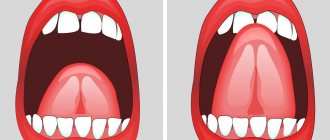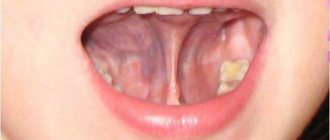Unfortunately, even parents who are not privy to medical subtleties are familiar with the opinion that a short frenulum of the tongue in a child is the cause of speech therapy problems.
Why "Unfortunately"? Because it is ignorance of the material that leads to a clear decision - the bridle needs to be trimmed! Do you remember in the film “Pokrovsky Gate” the characteristic female surgeon with her famous phrase “Cut!.. without waiting for peritonitis”? So the same thing often happens to the poor bridle. However, as experience shows, there is not always only one way out. Not every case of the so-called “short frenulum” requires radical measures.
What is a short frenulum of the tongue?
The frenulum is a thin partition that connects the tongue and the lower oral cavity. Normally, the frenulum is quite elastic, stretches well and is attached to the tongue in its middle part.
An abnormal structure may be the location of the frenulum closer to the edge of the tongue or even at its tip. In addition, a significant decrease in its elasticity, that is, its ability to stretch, is possible.
So in fact, the concept of “short bridle” is not entirely correct. Therefore, there is no clear solution to this issue.
Exercises to normalize breathing function
Exercise No. 1 Full breathing. Take a long breath through your nose. During inhalation, the abdomen “inflates”, then the chest expands. When you exhale (through the nose), on the contrary, the volume of the chest first decreases, then the stomach retracts.
Exercise No. 2 Chest breathing. Exhale. Take a long breath through your nose. At this time, the chest expands and the stomach retracts. When you exhale (through the nose), the stomach retracts.
Exercise No. 3 Abdominal breathing. Exhale. Take a long breath through your nose. At this time, the stomach protrudes. When you exhale (through the nose), the stomach retracts.
Exercise No. 4 The skill of full, extended exhalation. Walk at an average pace. Inhale and exhale only through the nose. Inhale for three steps, exhale for four steps. After three to four days, the duration of exhalation should be increased by one count (5,6, etc.)
Exercise No. 5 Inhale and exhale alternately through one nostril (press the second nostril tightly with your finger).
Exercise No. 6 Exhale. Pinch your nose with your fingers. Slowly count out loud to 5, then take a deep breath and exhale through your nose.
Exercises to strengthen the pharyngeal muscles
Exercise No. 1 Alternately tilt your head back as much as possible, leaning forward.
Exercise No. 2 Throw your head back. In this position, alternately tilt your head towards the right and left shoulder.
Exercise No. 3 Throw your head back, in this position alternately turn your head, without releasing your chin, to the right, then to the left.
What is the problem with the incorrect structure of the frenulum of the tongue?
In infants, an abnormal frenulum structure can cause difficulty sucking. In this case, the problem is solved in the maternity hospital by pruning. If the baby is still able to eat normally, doctors try to leave the situation alone, giving, as they say, time to grow. Indeed, in many cases, along with the growth of the jaw, the frenulum gradually stretches and takes on a normal shape.
In older children, a short hyoid frenulum creates some speech therapy difficulties:
- Difficulties arise with the pronunciation of hissing sounds.
- Correct reproduction of sonorants is not possible.
To pronounce the so-called upper lingual sounds, you need to raise the tip of your tongue upward. An insufficiently elastic bridle prevents this from being done.
However, it is very important to understand that it is not “responsible” for all speech problems. So if a child has a delay in speech development, syllables and sounds are “confused” in speech, a limited vocabulary or other problems, a short frenulum has nothing to do with it. The speech therapist will suggest effective methods of correction.
Exercises to stretch the frenulum of the tongue; consultation on speech therapy (senior group)
Memo for parents
How does the tongue frenulum affect a child’s speech?
The frenulum is a thin partition that connects the tongue and the lower oral cavity. Normally, the frenulum is quite elastic, stretches well and is attached to the tongue in its middle part.
An abnormal structure may be the location of the frenulum closer to the edge of the tongue or even at its tip. In addition, a significant decrease in its elasticity, that is, its ability to stretch, is possible.
What is the problem with the incorrect structure of the frenulum of the tongue?
In infants, an abnormal frenulum structure can cause difficulty sucking. In this case, the problem is solved in the maternity hospital by pruning. If the baby is still able to eat normally, doctors try to leave the situation alone, giving, as they say, time to grow. Indeed, in many cases, along with the growth of the jaw, the frenulum gradually stretches and takes on a normal shape.
In older children, a short hyoid frenulum creates some speech therapy difficulties:
- Difficulties arise with the pronunciation of hissing sounds.
- Correct reproduction of sonorants is not possible.
To pronounce the so-called upper lingual sounds, you need to raise the tip of your tongue upward. An insufficiently elastic bridle prevents this from being done.
However, it is very important to understand that it is not “responsible” for all speech problems. So if a child has a delay in speech development, syllables and sounds are “confused” in speech, a limited vocabulary or other problems, a short frenulum has nothing to do with it. The speech therapist will suggest effective methods of correction.
How to check if a child has a short frenulum
The presence of difficulties with the frenulum can be easily determined independently:
- Open your mouth slightly and place the tip of your tongue in the area behind your upper teeth. In this position, the place of attachment of the frenulum is clearly visible. If it is not “where it needs to be,” it is difficult to lift the tongue up.
- Pull your tongue forward. A short frenulum does not allow this to be done; in addition, the tip of the tongue visually looks forked
- Open your mouth and try to touch your upper lip with your tongue and lick it. Difficulties with the bridle make this movement difficult to perform.
Please note: sometimes a child cannot cope with these exercises not because there is something wrong with the frenulum. The cause may be weak muscles of the articulatory apparatus. Take a clean handkerchief and try to help your tongue. If resistance is felt when moving, then the problem is still in the hyoid frenulum.
Who to contact for help
Depending on the complexity of the situation, an orthodontist or speech therapist will help you cope with the problem. In any case, it makes sense to first get a consultation to decide what method of correction the child needs.
The dentist will carefully trim the frenulum, relieving the child of discomfort with one movement of his hand. However, recently doctors still recommend leaving surgical intervention as a last resort. An experienced speech therapist will offer a set of exercises and massage to stretch the frenulum.
Experts say that there are not many situations when the hyoid frenulum is absolutely unable to stretch. In almost all cases, a conservative approach achieves results.
A set of exercises for stretching the short frenulum of the tongue:
- "Painter". You must perform the exercise with your mouth wide open and a smile. The tip of the tongue should be drawn across the palate, starting from the teeth to the throat, while the lower jaw should not move. The exercise is accompanied by a rhyme:
- "Drum". Performed with an open mouth and a smile. The essence of the exercise is the repeated pronunciation of the letter [D]. It needs to be pronounced as clearly as possible. When pronouncing a sound, the tongue should rest against the upper teeth, and the mouth should be kept open. While doing this exercise, the child may involuntarily close his mouth; to prevent this from happening, you should hold a stick about 1 cm wide between his teeth, it could be a toothbrush handle or some other object.
- "Reach your nose." Just like in the previous exercises, you need to open your mouth and smile. The edge of the tongue must be pulled towards the nose and lowered towards the upper lip. Parents need to ensure that while performing these manipulations, the lips and lower jaw are motionless and the tongue is not compressed.
- "Swing". The child should smile and open his mouth, and on the count of “one or two,” alternately touch the upper and lower teeth. The lower jaw should remain motionless.
- "Football". The essence of the exercise is that you need to alternately press the tip of your tongue first to one cheek, then to the other, as if swinging a ball in your mouth.
- "Kitty". Children really like this exercise. You need to put some jam, ice cream or sour cream on a small plate and let the child lick the treat like a kitten.
- "Harmonic". The tongue should be pressed to the palate and, without lifting it, open and close the mouth.
- "Horse". Starting position: smile and open your mouth. Click your tongue like horses click. The tip of the tongue should not be pulled out or tucked down, and the lower jaw should remain motionless.
- "Fungus". The tongue should be pressed to the palate - this is the cap of the mushroom, and the frenulum is the leg, the lips should be kept in a smile.
- “Reach your chin.” In the process of performing the tenth exercise, the baby should reach with his tongue to the tip of the chin; the further he can reach, the greater the stretch of the frenulum.
How to do speech therapy massage for short tongue frenulum in children?
A special massage helps to lengthen the hyoid ligament very effectively. The child can do it independently or with the help of parents.
Massage to stretch the hyoid ligament:
- Using your thumb and index finger, you need to grab the tip of your tongue and lift it up. The mouth should be open during the massage. Using the fingers of the other hand, you need to move along the frenulum from bottom to top with stretching movements, as if pulling it out.
- The index and middle fingers should be placed under the tongue so that the frenulum is between them. Use your thumb to press on the front of the tongue and make outward lengthening movements. During such manipulation, the index and middle fingers should be motionless.
- The massage can be performed by simply stretching the tongue in different directions. Grasping the tip, carefully pull the tongue out.
Stretching the frenulum is an unpleasant and even slightly painful procedure for the child. There is no need to expect great results after two or three days of training; you should be patient and gradually move towards your goal.
How to check if a child has a short frenulum
The presence of difficulties with the frenulum can be easily determined independently:
- Open your mouth slightly and place the tip of your tongue in the area behind your upper teeth. In this position, the place of attachment of the frenulum is clearly visible. If it is not “where it needs to be,” it is difficult to lift the tongue up.
- Pull your tongue forward. A short frenulum does not allow this to be done; in addition, the tip of the tongue visually looks forked
- Open your mouth and try to touch your upper lip with your tongue and lick it. Difficulties with the bridle make this movement difficult to perform.
Please note: sometimes a child cannot cope with these exercises not because there is something wrong with the frenulum. The cause may be weak muscles of the articulatory apparatus. Take a clean handkerchief and try to help your tongue. If resistance is felt when moving, then the problem is still in the hyoid frenulum.
Three ways to stage
Is your baby able to do articulation exercises? You can proceed to the next stage - sound production. The speech therapist has mechanical techniques in his arsenal.
- Spatula and nipple technique. The doctor places the pacifier on a wooden spatula. The student assumes the “Airplane drone” position. The specialist makes rapid movements under the tip of the tongue until it begins to vibrate. Movements - up and down, left and right. This technique is more effective if the baby's head is on the doctor's lap.
- Vibration - using paper. A wad of paper is placed on the tip of the tongue, a string is tied to it so that the paper does not fall on the floor, and it is given to the baby. He hides his tongue behind his upper teeth and tries to blow the paper off his tongue.
- Repetitions of the sound "d". The student sits in front of a mirror, opens his mouth slightly, places the tip of his tongue at the beginning of the upper teeth and quickly repeats “d-d-d-d.” Then he connects “d” with vowels: “d-d-a”, “a-d-d” and then the rest of the letters.
At this time, the specialist places a spatula under the front edge of the tongue and carries out frequent oscillatory movements. This contributes to the pronunciation of the rumble that is characteristic of vibrant.
Who to contact for help
Depending on the complexity of the situation, an orthodontist or speech therapist will help you cope with the problem. In any case, it makes sense to first get a consultation to decide what method of correction the child needs.
The dentist will carefully trim the frenulum, relieving the child of discomfort with one movement of his hand. However, recently doctors still recommend leaving surgical intervention as a last resort. An experienced speech therapist will offer a set of exercises and massage to stretch the frenulum.
Experts say that there are not many situations when the hyoid frenulum is absolutely unable to stretch. In almost all cases, a conservative approach achieves results.
Parents can evaluate the pros and cons of different approaches on their own.
Surgical method:
- A quick, radical solution to the problem.
- The operation is performed using anesthesia.
- The healing process takes some time and is uncomfortable.
- Dietary restrictions due to surgery.
- It is advisable to maintain vocal rest for several days.
- Psychological trauma in the child is possible.
- After the operation, classes with a speech therapist are necessary to correct sound pronunciation.
Frenum stretching method:
- Conservative, does not cause psychological difficulties in the child.
- Effective in most cases.
- Does not require changes to your usual routine.
- It takes some time (several months).
- Requires discipline and regular practice.
In any case, to resolve the issue, you need to consult a speech therapist.
Reviews
“We had plastic surgery on our daughter’s short frenulum of her upper lip when she was 6 years old. The procedure was recommended to us by a dentist at the Smile clinic. The whole process took literally a few minutes, they calmed my daughter down, gave her an injection in her gum, so there were no tears. Everything healed within 10 days, there were no problems or complications. Thanks to all the medical staff of the clinic for their professionalism and kind attitude towards children!” Maria, 30 years old
“Before correcting the bite, the dentist recommended cutting the frenulum, due to which there was a gap between my front teeth. Everything went quickly and painlessly. Now I recommend your clinic to my friends.” Olga, 27 years old
“My son had problems with diction due to a short frenulum of the lip. I was very worried about how he would cope with the operation, but the specialists at the Smile clinic quickly found an approach to him and did everything very well. Thank you!" Marina, 33 years old
A short frenulum of the upper lip is a condition that requires proper correction. Lip frenuloplasty is performed without pain and in just one visit to the dentist. The recovery period proceeds easily and without significant restrictions. At the Smile clinic we find an individual approach to patients of any age and in treatment we are guided only by proven, modern methods.











